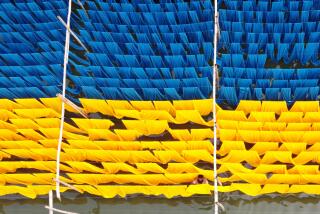This fabric captures energy to power your electronic devices

- Share via
In the future, your clothes will work for you. A team of scientists led out of the Georgia Institute of Technology has created a fabric that can gather energy from both sunlight and motion, then store it in embedded fibers.
The textile, described in Science Advances, could help pave the way for energy-harvesting clothes and new wearable devices.
Scientists and engineers have been working for years on creating fabrics that, if worn, could harvest energy for the wearer, said senior author Zhong Lin Wang, a nanotechnologist at Georgia Tech.
“The objective was to harvest energy from our living environment, for example, human walking or muscle movement and fabric; the goal is to drive small electronics,” he said. “And this research recently attracted a lot of attention because these days, flexible electronics, wearable electronics, have become very popular and fashionable today. But each of them needs a power source.”
It’s not an easy task to make devices that can be flexible enough to create a material that can actually be sewn into shirts, jackets or other garments. Wang’s team, for one, has been working on various aspects of this early-stage technology for 11 years.
On top of that, any energy would have to be stored in some way that didn’t involve carrying around a bulky battery.
Wang and his team solved these issues by creating a triple-threat (or perhaps, a triple-thread) fabric: It uses dye-sensitized solar cells shaped into long fibers to harvest light energy; it uses fiber-shaped triboelectric nanogenerators to harvest electrostatic charges made by normal movement; and it also uses fiber-shaped supercapacitors to store the energy in electrochemical form.
Under sunlight, the solar cells provide the majority of the power; but indoors or on a cloudy day, the movement-based fibers pick up the slack, Wang said. (He was quick to add that you don’t need to flap your arms or do anything dramatic — the fibers will gather energy from small, normal movements.)
“Our idea is to try to use whatever is available, whenever it’s available,” he said.
The researchers have a roughly 225-square-centimeter (or 35-square-inch) patch of the energy-harvesting fabric that’s roughly as flexible as woven straw. The scientists hope to make it as flexible as common cloth.
The key to that, Wang said, is thinner fibers. Currently they’re 15 to 20 centimeters long and about 2 millimeters wide. Once they reach about half a millimeter in width, they will be much more pliant, he added.
But that’s if you were to make a device entirely out of these fibers. Theoretically, a few of these fibers also could be woven into any kind of textile, such as cotton, and offer some energy-harvesting benefits without sacrificing softness and flexibility, Wang said.
While the technology could allow users to charge phones and wearable devices, it also could make interactive garments — a gown with LED lights, for example — more feasible for fashion designers. The research also could prove useful for building flexible screens, designing heart and other health monitors, and may even find applications in robotics.
“I think it’s an exciting development,” said Thomas Thundat, a physicist in the chemical and materials engineering department at the University of Alberta in Canada, who was not involved in the study.
“Wearable and portable devices are getting popular, and I believe that they will revolutionize our society in the near future,” Thundat said. “But the biggest problem is the batteries.”
Wang’s new fabric helps solve that power problem, said Thundat, who envisioned a range of possible applications.
Electronics embedded in smart clothing could heat you in the winter or keep you cool when working outside in the summer, he said. They could monitor the temperature, humidity and toxins in the environment, warning of extreme pollution or chemical exposure.
Before the technology gets there, however, Wang ticked off the items on his to-do list.
“There’s a lot of things to do: Number one is to get the fiber thinner, so more flexible,” he said. “Number two is to improve the durability or robustness, so they can last longer. And third is, we have to work on continuing to improve the performance. The more power, the better.”
Follow @aminawrite on Twitter for more science news and “like” Los Angeles Times Science & Health on Facebook.
MORE IN SCIENCE
Neuroscientists show how tiny fibs snowball into big lies
In the motions of distant solar system objects, astronomers find hints of Planet Nine
Scientists may have a cure for jet lag: Temporary oxygen deprivation
UPDATES:
Oct. 28, 11 a.m.: This article has been updated with comments from physicist Thomas Thundat.
This article was originally published at 12:05 p.m. Oct. 26.







